
Cucurbita pepo is a cultivated plant of the genus Cucurbita. It yields varieties of winter squash and pumpkin, but the most widespread varieties belong to the subspecies Cucurbita pepo subsp. pepo, called summer squash.

Rudbeckia is a plant genus in the Asteraceae or composite family. Rudbeckia flowers feature a prominent, raised central disc in black, brown shades of green, and in-between tones, giving rise to their familiar common names of coneflowers and black-eyed-susans. All are native to North America, and many species are cultivated in gardens for their showy yellow or gold flower heads that bloom in mid to late summer.
Silverpuffs is a common name for several plants and may refer to:

Arbutus xalapensis, commonly known as the Texas madrone, Amazaquitl, or Texas madroño, is a species of flowering plant in the heather family. It is native to Central America, the southwestern United States, and throughout Mexico. It is found in canyons and mountains, on rocky plains, and in oak woodlands, at altitudes of up to 3,000 m in the south of the range, but lower, down to 600 m in the north of the range.
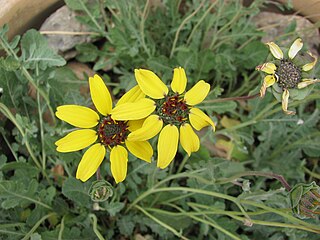
Berlandiera is a genus of flowering plants in the family Asteraceae.

Allolepis is a genus of North American plants in the grass family.

Chaptalia is a genus of flowering plants in the family Asteraceae.

Diospyros texana is a species of persimmon that is native to central, south and west Texas and southwest Oklahoma in the United States, and eastern Chihuahua, Coahuila, Nuevo León, and Tamaulipas in northeastern Mexico. Common names include Texas persimmon, Mexican persimmon and the more ambiguous "black persimmon". It is known in Spanish as chapote, chapote manzano, or chapote prieto, all of which are derived from the Nahuatl word tzapotl. That word also refers to several other fruit-bearing trees.
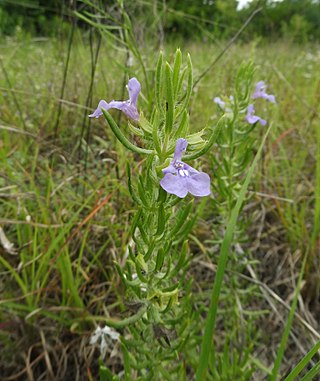
Salvia texana, commonly called Texas sage, is a species of flowering plant in the mint family (Lamiaceae). It is native to North America, where it is found in northern Mexico, and in the U.S. states of Texas and New Mexico. Its natural habitat is dry areas on limestone soils, in prairies or over rock outcrops.
Gutierrezia texana is a North American species of flowering plant in the family Asteraceae known by the common name Texas snakeweed. It is native to the south-central United States and northern Mexico as far south as Guanajuato and Hidalgo.

Anthanassa texana, the Texan crescentspot, is a species of butterfly in the family Nymphalidae. It is found from Guatemala north through Mexico to southern California, east across the southern United States to northern Florida, Georgia and South Carolina. Strays may be found up to Arkansas, Missouri, Illinois, South Dakota, and central Nevada. The habitat consists of deserts, dry gulches, open areas, streamsides, road edges, and city parks.

Chaptalia tomentosa, common name pineland daisy, is a plant species native to the southeastern United States. It has been reported from southern Alabama, Florida, southern Georgia, Louisiana, eastern Texas, southern Mississippi, eastern North Carolina and South Carolina. Some publications report the species from the West Indies as well, but this is based on the assumption that C. azurensis is a synonym of C. tomentosa.
Chaptalia albicans, the white sunbonnet, is a plant species native to Mexico, Central America and the West Indies. It is known from Jamaica, Cuba, Guatemala, Belize, Honduras, southern Florida, the Bahamas, Hispaniola, Puerto Rico, San Luis Potosí, Veracruz, Yucatán, Campeche and Chiapas.
Baccharis texana is a North American species of shrubs in the family Asteraceae known by the common name prairie baccharis or false willow. It is native to northeastern Mexico and to the southern part of the Great Plains of the United States.
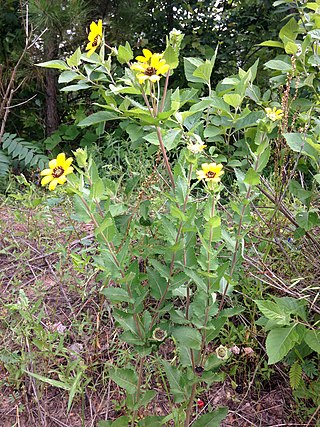
Berlandiera texana is a North American species of flowering plant in the family Asteraceae. It is commonly known as Texas greeneyes. It is native to the south-central United States, in the states of Texas, New Mexico, Oklahoma, Kansas, Missouri, Arkansas, and Louisiana.

Haploesthes greggii, common name false broomweed, is a North American species of flowering plants in the family Asteraceae. It grows in northeastern Mexico and in the south-central and southwestern United States.
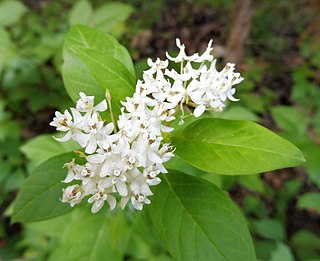
Asclepias texana, commonly called Texas milkweed, is a species of flowering plant in the dogbane family (Apocynaceae). It is native to North America, where it is widespread in the regions of the Chihuahuan Desert and Edwards Plateau. Its range spans from the states of Durango and Coahuilla in Mexico, north to the state of Texas in the United States. Its natural habitat is in dry rocky areas in canyons or along arroyos.
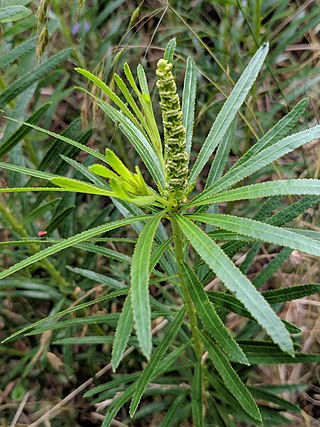
Stillingia texana, the Texas toothleaf, is a species of flowering plant in the family Euphorbiaceae. It is native to the South Central United States and Mexico. In central Texas it is widespread in upland, calcareous prairies, spreading north to scattered locations in Oklahoma and south to Coahuila. Stillingia texana was described in 1923 by Ivan Murray Johnston.

Lindheimera texana, commonly known as Texas yellow star, is a species of flowering plant in the tribe Heliantheae within the family Asteraceae. It is found in the south-western United States and northern Mexico (Coahuila). Other common names include star daisy, Texas star and Lindheimer daisy,

Lygodesmia texana, the Texas skeleton plant, is a species of flowering plant in the family Asteraceae, native to the US states of New Mexico, Texas, and Oklahoma, and to northeastern Mexico. A perennial reaching at most 2 ft (60 cm), it prefers to grow on well-drained limestone soil and blooms from April to August.















